-

新人教版高中英语选修2Unit 4 Learning about Language教学设计
This section guides students to pay attention to the typical context of vocabulary use, helps students accumulate vocabulary around the key vocabulary of this unit, and uses the learned words and word chunks in different contexts to deeply understand their meaning and usage, so as to achieve the purpose of review and consolidation.The teaching design activities aim to guide students to pay attention to the typical context in which the target vocabulary is used, as well as the common vocabulary used in collocation, so that students can complete the sentence with correct words. In terms of vocabulary learning strategies, this unit focuses on cultivating students' ability to pay attention to collocation of words and to use word blocks to express meaning.For vocabulary learning, it is not enough just to know the meaning of a single word, but the most important thing is to master the common collocations of words, namely word blocks.Teachers should timely guide students to summarize common vocabulary collocation, such as verb and noun collocation, verb and preposition collocation, preposition and noun collocation, and so on.1. Guide students to understand and consolidate the meaning and usage of the vocabulary in the context, 2. Guide the students to use the unit topic vocabulary in a richer context3. Let the students sort out and accumulate the accumulated vocabulary, establishes the semantic connection between the vocabulary,4. Enable students to understand and master the vocabulary more effectivelyGuiding the Ss to use unit topic words and the sentence patterns in a richer context.

新人教版高中英语选修2Unit 4 Reading for writing教学设计
假定你是英国的Jack,打算来中国旅行,请你给你的中国笔友李华写一封信,要点如下:1.你的旅行计划:北京→泰山→杭州;2.征求建议并询问他是否愿意充当你的导游。注意:1.词数80左右(开头和结尾已给出,不计入总词数);2.可以适当增加细节,以使行文连贯。参考词汇:故宫 the Forbidden City;泰山 Mount TaiDear Li Hua,I'm glad to tell you that 'm going to visit China.First,I am planning to visit Beijing,the capitalof China,where I am looking forward to enjoying the Great Wall,the Forbidden City and somebeautiful parks.Then I intend to go to visit Mount Tai in Shandong Province.I've heard that it is one ofthe most famous mountains in China and I can't wait to enjoy the amazing sunrise there.After that,I amalso going to Hangzhou.It is said that it is a beautiful modern city with breathtaking natural sights,among which the West Lake is a well- known tourist attraction.What do you think of my travel plan? Will you act as my guide? Hope to hear from you soon.

新人教版高中英语选修2Unit 4 Using langauge-Listening教学设计
The theme of the listening section is " talking about scenery and culture along a journey."The part is designed to further lead the students to understand Canadian natural geography and social environment, and integrated into the cultural contrast by mentioning the long train journey from Beijing to Moscow routes. On this basis, the part activates students related travel experience, lets the student serial dialogue, guides the student to explore further the pleasure and meaning of the long journey, and Chinese and foreign cultural comparison.The part also provides a framework for the continuation of the dialogue, which is designed to provide a framework for students to successfully complete their oral expressions, and to incorporate an important trading strategy to end the dialogue naturally.1. Help students to understand and master some common English idioms in the context, and experience the expression effect of English idioms.2. Guide the students to understand the identity of different people in the listening context, and finish the dialogue according to their own experience.3. Instruct the students to use appropriate language to express surprise and curiosity about space and place in the dialogue, and master the oral strategy of ending the dialogue naturally.1. Instruct students to grasp the key information and important details of the dialogue.2. Instruct students to conduct a similar talk on the relevant topic.

新人教版高中英语选修2Unit 5 Learning about Language教学设计
The purpose of this section of vocabulary exercises is to consolidate the key words in the first part of the reading text, let the students write the words according to the English definition, and focus on the detection of the meaning and spelling of the new words. The teaching design includes use English definition to explain words, which is conducive to improving students' interest in vocabulary learning, cultivating their sense of English language and thinking in English, and making students willing to use this method to better grasp the meaning of words, expand their vocabulary, and improve their ability of vocabulary application. Besides, the design offers more context including sentences and short passage for students to practice words flexibly.1. Guide students to understand and consolidate the meaning and usage of the vocabulary in the context, 2. Guide the students to use the unit topic vocabulary in a richer context3. Let the students sort out and accumulate the accumulated vocabulary, establishes the semantic connection between the vocabulary,4. Enable students to understand and master the vocabulary more effectivelyGuiding the Ss to use unit topic words and the sentence patterns in a richer context.Step1: Read the passage about chemical burns and fill in the blanks with the correct forms of the words in the box.

新人教版高中英语选修2Unit 5 Reading and thinking教学设计
The theme of this activity is to learn the first aid knowledge of burns. Burns is common in life, but there are some misunderstandings in manual treatment. This activity provides students with correct first aid methods, so as not to take them for granted in an emergency. This section guides students to analyze the causes of scald and help students avoid such things. From the perspective of text structure and collaborative features, the text is expository. Expository, with explanation as the main way of expression, transmits knowledge and information to readers by analyzing concepts and elaborating examples. This text arranges the information in logical order, clearly presents three parts of the content through the subtitle, accurately describes the causes, types, characteristics and first aid measures of burns, and some paragraphs use topic sentences to summarize the main idea, and the level is very clear.1. Guide students to understand the causes, types, characteristics and first aid methods of burns, through reading2. Enhance students’ ability to deal withburnss and their awareness of burns prevention3. Enable students to improve the ability to judge the types of texts accurately and to master the characteristics and writing techniques of expository texts.Guide students to understand the causes, types, characteristics and first aid methods of burns, through readingStep1: Lead in by discussing the related topic:1. What first-aid techniques do you know of ?CPR; mouth to mouth artificial respiration; the Heimlich Manoeuvre

新人教版高中英语选修2Unit 5 Using langauge-Listening教学设计
The theme of this section is to learn how to make emergency calls. Students should learn how to make emergency calls not only in China, but also in foreign countries in English, so that they can be prepared for future situations outside the home.The emergency telephone number is a vital hotline, which should be the most clear, rapid and effective communication with the acute operator.This section helps students to understand the emergency calls in some countries and the precautions for making emergency calls. Through the study of this section, students can accumulate common expressions and sentence patterns in this context. 1.Help students accumulate emergency telephone numbers in different countries and learn more about first aid2.Guide the students to understand the contents and instructions of the telephone, grasp the characteristics of the emergency telephone and the requirements of the emergency telephone.3.Guide students to understand the first aid instructions of the operators.4.Enable Ss to make simulated emergency calls with their partners in the language they have learned1. Instruct students to grasp the key information and important details of the dialogue.2. Instruct students to conduct a similar talk on the relevant topic.Step1:Look and discuss:Match the pictures below to the medical emergencies, and then discuss the questions in groups.
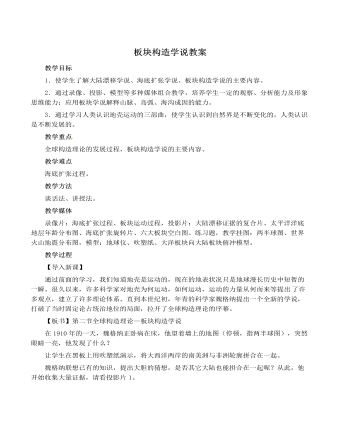
人教版高中地理选修1板块构造学说教案
【启发想象 】能否将刚才讲的内容用一个游泳动作形容一下?这好像蛙泳动作。我们大家一起做:熔岩冒出(双手合十向上)→推向两边(双手向两侧分开)→遇陆俯冲(双手往下)→重熔再生(双手相向合并向上)。【小结板书】二、海底扩张学说前面我们学习了两个假说,整理一下已知条件:事实证明大陆是在漂移的,如欧洲与美洲的距离在扩张,但是漂移的动力不足;海底是不断扩张的,有生长与消亡。能否在前人研究的基础上,提出更准确更合理的假设呢?一个新的理论诞生了,它是目前最盛行、最活跃的全球构造理论【板书】三、板块构造学说1.板块概念学生读书。【启发提问】板块“漂移”与大陆“漂移”的位置有何不同?学生回答。板块漂移是指岩石圈漂在软流层上,大陆漂移发生在地壳两层之间。【提问】板块是如何划分的?读图用半分钟记下六大板块的位置和名称(提示:按大洲和大洋名称记忆)。
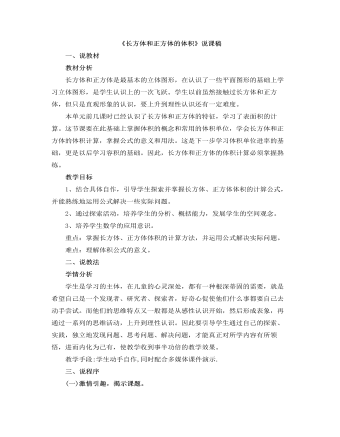
小学数学人教版五年级下册《长方体和正方体的体积》说课稿
本单元前几课时已经认识了长方体和正方体的特征,学习了表面积的计算。这节课要在此基础上掌握体积的概念和常用的体积单位,学会长方体和正方体的体积计算,掌握公式的意义和用法。这是下一步学习体积单位进率的基础,更是以后学习容积的基础。因此,长方体和正方体的体积计算必须掌握熟练。教学目标1、结合具体自作,引导学生探索并掌握长方体、正方体体积的计算公式,并能熟练地运用公式解决一些实际问题。 2、通过探索活动,培养学生的分析、概括能力,发展学生的空间观念。 3、培养学生数学的应用意识。 重点:掌握长方体、正方体体积的计算方法,并运用公式解决实际问题。 难点:理解体积公式的意义。
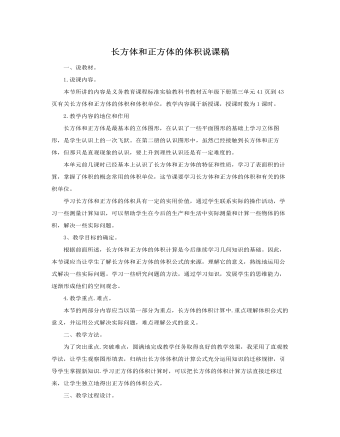
人教版新课标小学数学五年级下册长方体和正方体的体积说课稿
正方体的体积=棱长×棱长×棱长用字母a表示棱长,V=a×a×a.也可以写成a3读作a的立方.表示3个a相乘.不要误认为a与3相乘。写a3时3写在a的右上角要写小些.所以正方体的体积公式一般写成: V=a3(五)、巩固练习、运用公式练习是数学中教学巩固新知、形成技能、发展思维、提高学生分析问题、解决问题能力的有效手段,为了加强学生的理解,使学生能正确运用公式.我设计了多层次的练习。1、通过让学生完成看图求体积,这样有助于学生理解长方体正方体的体积与它的长宽高的关系,记住长方体的体积计算公式.2、我对安排了四个判断题,以加深学生对a的立方的理解和运用。3,解决实际问题,我安排了两道题目的是让学生所学新知识解决生活中的一些实际问题。
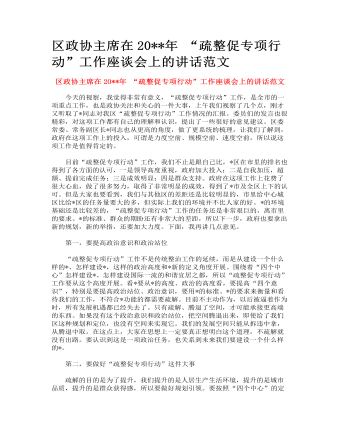
区政协主席在 “疏整促专项行动”工作座谈会上的讲话范文
第一,要提高政治意识和政治站位 “疏整促专项行动”工作不是传统整治工作的延续,而是从建设一个什么样的*、怎样建设*,这样的政治高度和*新的定义角度开展。围绕着“四个中心”怎样建设*、怎样建设国际一流的和谐宜居之都,所以“疏整促专项行动”工作要从这个高度开展。看*要从*的高度、政治的高度看,要提高“四个意识”,特别是要提高政治站位、政治意识,要用*的标准、*的要求来衡量和看待我们的工作,不符合*功能的都需要疏解。目前不主动作为,以后被逼着作为时,所有发展机遇都已经失去了。只有疏解、腾退了空间,才可能承接更高端的东西。如果没有这个政治意识和政治站位,把空间腾退出来,即使给了我们区这种规划和定位,也没有空间来实现它。我们的发展空间只能从拆违中拿,从腾退中取。在这点上,大家在思想上一定要真正想明白这个道理,不疏解就没有出路。要认识到这是一项政治任务,也关系到未来我们要建设一个什么样的*。 第二,要做好“疏整促专项行动”这件大事 疏解的目的是为了提升,我们提升的是人居生产生活环境,提升的是城市品质,提升的是群众获得感,所以要做好规划引领。要按照“四个中心”的定位和*的标准,高水平、高层次的超前规划、超前设计。一是要符合生态特性,*是*的西南生态屏障,也是*的一个重要定位,未来*建设要突出生态特色、科技特色、文化特色,这是*未来发展的方向。二是要保障民生,这也是委员们多次提到的问题,过去小散乱污不环保、不高端,但是方便。现在整治后,环境、产业、品质都提升了,但是不方便了。在提升的同时便民服务设施要提早规划好、建设好。还要尽量为群众多留绿色空间,我们一切工作的最终目的都是让*老百姓过上更好的生活。三是要加强社会监督、舆论监督、群众监督。“疏整促专项行动”工作应该是全员参与的工作,不能政府干,群众看,要让老百姓参与进来,利用好新媒体,加大宣传,建立举报监督奖励机制,让更多的老百姓参与进来,真正发挥群众的力量,打一场拆违的人民战争,建立一种监督执法的长效机制。
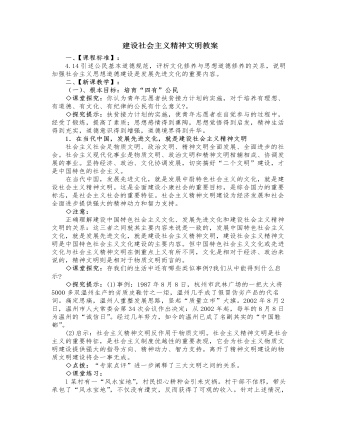
人教版高中政治必修3建设社会主义精神文明教案
(2)伟大的意义:这些精神文明创建活动,是人民群众“移风易俗”、改造社会的伟大创造,也是人民群众自我教育、自我提高的有效途径。各具特色的精神文明创建活动,使人们在自觉参与的过程中思想感情得到熏陶,思想觉悟得到启发,精神生活得到充实,道德意识得到增强,道德境界得到升华。这对整个中华民族的精神面貌,正在产生不可估量的积极影响。◇点拨:“相关链接”描述了青年志愿者活动,引导学生感悟其精神,升华道德境界,增强参与意识。(3)必然的选择:投身于社会主义精神文明建设的伟大实践,做新时期中国先进文化的传播者和建设者,是当代中国青年成长、成才的必然选择。◇拓展延伸:在群众性精神文明创建活动中涌现出的先进人物和英雄模范,像孔繁森、张海迪、徐洪刚、韩素云、李国安、徐虎、李素丽等,在全社会起到了良好的示范作用;提出的一些响亮口号,如“从我做起,从现在做起”“岗位学雷锋,行业树新风”“单位做个好职工,社会做个好公民,家庭做个好成员”等,不断激励着人们。
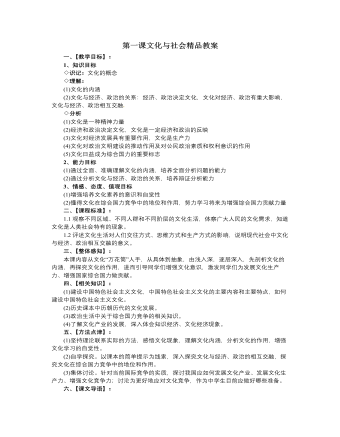
人教版高中政治必修3第一课文化与社会精品教案
(2)历史课本中历朝历代的文化发展。(3)政治生活中关于综合国力竞争的相关知识。(4)了解文化产业的发展,深入体会知识经济、文化经济现象。五、【方法点津】:(1)坚持理论联系实际的方法,感悟文化现象,理解文化内涵,分析文化的作用,增强文化学习的自觉性。(2)自学探究。以课本的简单提示为线索,深入探究文化与经济、政治的相互交融,探究文化在综合国力竞争中的地位和作用。(3)集体讨论。针对当前国际竞争的实质,探讨我国应如何发展文化产业、发展文化生产力、增强文化竞争力;讨沦为更好地应对文化竞争,作为中学生目前应做好哪些准备。六、【课文导语】:文化,一个我们十分熟悉的词汇。然而“熟知并非真知”。有人说,文化是知识;有人说,文化是艺术。究竟什么是“文化”?只要在社会生活中细细体味,我们就能真切地感悟“文化”的内涵与文化的力量。

人教版高中政治必修4第十课创新意识与社会进步精品教案
在数学上,0这个数是解决记数和进位问题而引进的概念,由于它不能表示实在的东西,很长时间人们不把它看作是一个数。认为0是无,是对有的否定。从唯物辩证法的观点看,这种否定不是形而上学的简单否定,而是具有丰富内容的辨证否定。辨证的否定是发展的环节。0是从无到有的必经之路,是连接无和有的桥梁。0又是正数和负数之间的界限,它既否定了任何正数,也否定了任何负数,是唯一的中性数。但它又是联结正数和负数的中间环节。没有0,负数就过渡不到正数去,正数也休想发展到负数来。数学中的0是对任何定量的否定。如果没有这一否定,任何量的发展都无从谈起。这个否定不是一笔勾销,而是扬弃。因为它克服了任何定量的有限性,成为其发展的环节。在现实生活中,0作为辨证的否定,也体现出联系和发展的性质。如0度不是没有温度,而是非常确定的温度。
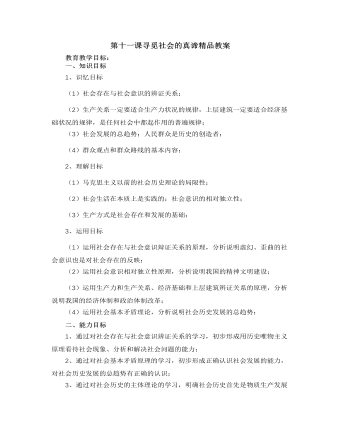
人教版高中政治必修4第十一课寻觅社会的真谛精品教案
A生产方式是人类社会存在和发展的基础人要生存必须有吃、穿、住、用等物质生活资料,只有生存问题解决了才能谈得上社会的存在和发展,才能从事其他的活动(教育、艺术、体育、政治)。而要获得物质生活资料,必须从事物质资料的生产劳动。在这一活动中,形成了现实的生产力和生产关系,即生产方式。【思想教育】落后必然挨打,我国大力发展经济,就是为了发展生产力。发展是硬道理,中国解决一切问题的关键在与自己的发展。要积极支持改革开放,积极投身于经济建设中去。现在学好知识将来教育育人,为社会培养更多的合格人才。B生产方式决定着社会的性质和面貌社会生活纷繁复杂,包括经济生活、政治生活、精神生活、婚姻家庭生活等许多方面。这些方面都受生产方式的制约,有什么样的生产方式,就有什么样的社会结构;不同的生产方式,表现为不同性质的社会形态。社会的整个面貌只能从生产方式中得到科学的说明。【举例】家庭联产承包责任制的产生与推广1958年的人民公社化运用曾使中国农民在劳动和分配上都实行绝对的平均主义,大锅饭的结果是饭越吃越少,人越过越穷。
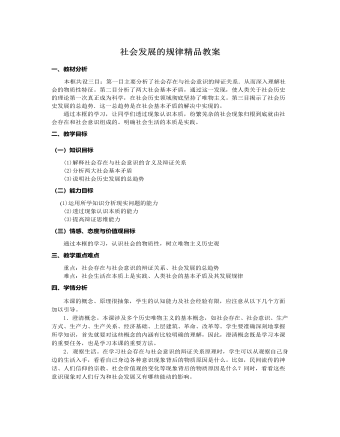
人教版高中政治必修4社会发展的规律精品教案
四、学情分析本课的概念、原理很抽象,学生的认知能力及社会经验有限,应注意从以下几个方面加以引导。1.澄清概念。本课涉及多个历史唯物主义的基本概念,如社会存在、社会意识、生产方式、生产力、生产关系、经济基础、上层建筑、革命、改革等。学生要准确深刻地掌握所学知识,首先就要对这些概念的内涵有比较明确的理解,因此,澄清概念既是学习本课的重要任务,也是学习本课的重要方法。2.观察生活。在学习社会存在与社会意识的辩证关系原理时,学生可以从观察自己身边的生活入手,看看自己身边各种意识现象背后的物质原因是什么。比如,民间流传的神话、人们信仰的宗教、社会价值观的变化等现象背后的物质原因是什么?同时,看看这些意识现象对人们行为和社会发展又有哪些能动的影响。
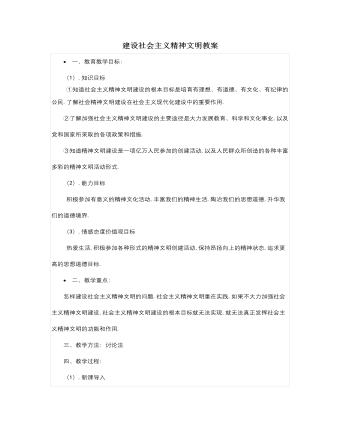
人教版高中政治必修3建设社会主义精神文明教案
师:三亚目前正在强调打造文化产业,如举办文体大赛,提升三亚知名度.如今"美丽三亚,浪漫天涯"已成为三亚一张旅游名片,以文化产业的发展带动经济旅游的发展,大家结合今天的三亚文化产业发展谈谈发展文化事业和文化产业的作用.学生:回答(略)。师:要支持文化产业发展,增强我国文化产业的整体实力和竞争力.? 3. 亿万人民的创建活动(板书) (1).人民群众是精神文明创建活动的主体。学生朗读课文P103页,理解亿万人民是精神文明创建活动的主体.师:发展先进文化,本质上是一个立足于建设中国特设社会主义伟大实践而不断进行文化创造的过程,也就是社会主义精神文明的创建过程.(2).人民群众参与精神文明创建活动的意义.师:人民群众在社会主义精神文明建设活动中,创造了丰富多彩的形式,在参与的过程中思想感情得到熏陶,思想觉悟得到启发,精神生活得到充实,道德意识得到增强,道德境界得到升华.这对整个中华民族的精神面貌,正在产生不可估量的积极影响.
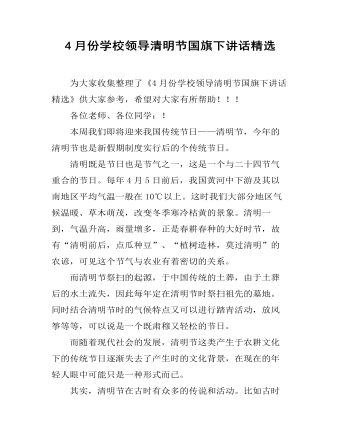
4月份学校领导清明节国旗下讲话精选
为大家收集整理了《4月份学校领导清明节国旗下讲话精选》供大家参考,希望对大家有所帮助!!!各位老师、各位同学:!本周我们即将迎来我国传统节日——清明节,今年的清明节也是新假期制度实行后的个传统节日。清明既是节日也是节气之一,这是一个与二十四节气重合的节日。每年4月5日前后,我国黄河中下游及其以南地区平均气温一般在10℃以上。这时我们大部分地区气候温暖、草木萌茂,改变冬季寒冷枯黄的景象。清明一到,气温升高,雨量增多,正是春耕春种的大好时节,故有“清明前后,点瓜种豆”、“植树造林,莫过清明”的农谚,可见这个节气与农业有着密切的关系。而清明节祭扫的起源,于中国传统的土葬,由于土葬后的水土流失,因此每年定在清明节时祭扫祖先的墓地。同时结合清明节时的气候特点又可以进行踏青活动,放风筝等等,可以说是一个既肃穆又轻松的节日。而随着现代社会的发展,清明节这类产生于农耕文化下的传统节日逐渐失去了产生时的文化背景,在现在的年轻人眼中可能只是一种形式而已。其实,清明节在古时有众多的传说和活动。比如古时清明前一天为“寒食节”,相传春秋时期晋文公悼念介子推“割股充饥”一事,后逐渐清明节寒食节合而为一。
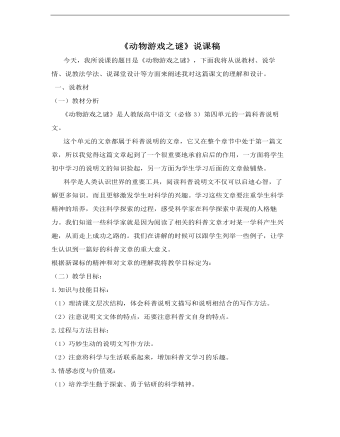
高中语文人教版必修三《动物游戏之谜》说课稿
科学是人类认识世界的重要工具,阅读科普说明文不仅可以启迪心智,了解更多知识。而且更够激发学生对科学的兴趣。学习这些文章要注重学生科学精神的培养,关注科学探索的过程,感受科学家在科学探索中表现的人格魅力。我们知道一些科学家就是因为阅读了相关的科普文章才对某一学科产生兴趣,从而走上成功之路的。我们在讲解的时候可以跟学生列举一些例子,让学生认识到一篇好的科普文章的重大意义。
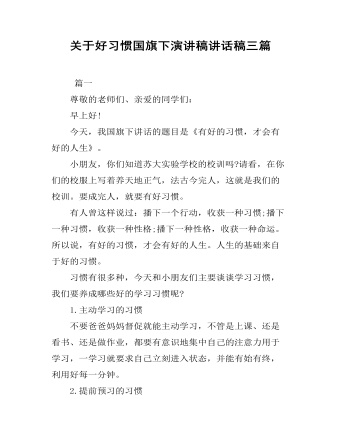
关于好习惯国旗下演讲稿讲话稿三篇
篇一尊敬的老师们、亲爱的同学们:早上好!今天,我国旗下讲话的题目是《有好的习惯,才会有好的人生》。小朋友,你们知道苏大实验学校的校训吗?请看,在你们的校服上写着养天地正气,法古今完人,这就是我们的校训。要成完人,就要有好习惯。有人曾这样说过:播下一个行动,收获一种习惯;播下一种习惯,收获一种性格;播下一种性格,收获一种命运。所以说,有好的习惯,才会有好的人生。人生的基础来自于好的习惯。习惯有很多种,今天和小朋友们主要谈谈学习习惯,我们要养成哪些好的学习习惯呢?1.主动学习的习惯不要爸爸妈妈督促就能主动学习,不管是上课、还是看书、还是做作业,都要有意识地集中自己的注意力用于学习,一学习就要求自己立刻进入状态,并能有始有终,利用好每一分钟。2.提前预习的习惯课前预习可以提高课上的学习效率,预习时把新的内容提前读一读,用工具书查一查,向爸爸妈妈问一问,把不懂的问题做好标记,课上就要有重点地去听。
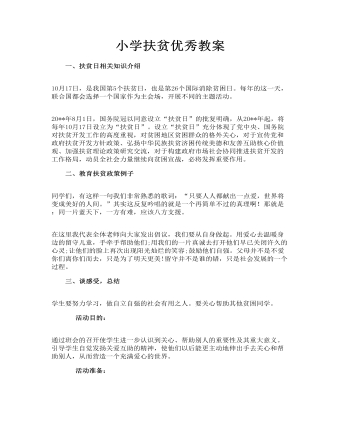
小学扶贫优秀教案
二、教育扶贫政策例子 同学们,有这样一句我们非常熟悉的歌词:“只要人人都献出一点爱,世界将变成美好的人间。”其实这反复吟唱的就是一个再简单不过的真理啊!那就是:同一片蓝天下,一方有难,应该八方支援。 在这里我代表全体老师向大家发出倡议,我们要从自身做起。用爱心去温暖身边的留守儿童,手牵手帮助他们;用我们的一片真诚去打开他们早已关闭许久的心灵;让他们的脸上再次出现阳光灿烂的笑容;鼓励他们自强。父母并不是不爱你们离你们而去,只是为了明天更美!留守并不是谁的错,只是社会发展的一个过程。

